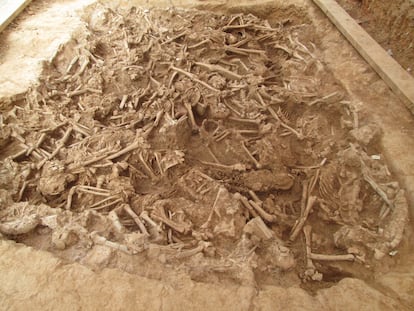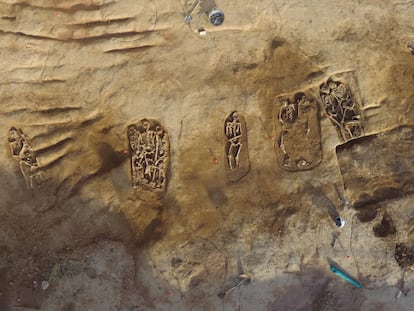DNA study of soldiers from 1652 siege of Barcelona reveals unknown epidemic
Researchers found no traces of the plague in the Basque and Sardinian fighters, but instead a type of bacteria from the salmonella genus that causes paratyphoid fever

Several years ago, the construction of La Sagrera high-speed AVE train station in Barcelona turned up more than 500 corpses. Some lay in small pits containing four or five bodies and others were crammed into mass graves containing more than 70 skeletons. The corpses belonged to soldiers who were fighting for King Felipe IV and who died in 1652 during the siege of Barcelona.
This episode is known in Catalan as the Guerra dels Segadors or Reapers’ War on account of the peasants who armed themselves with sickles to fight alongside the French king, Louis XIII, against the Spanish monarch. The revolt inspired the official anthem of Catalonia, Els Segadors, which includes lyrics such as: “May the enemy tremble/at the sight of our symbol/ as we cut golden ears of wheat/ when the time calls we sever chains.” Now, a study shows that many of the fallen on both sides of the battle were probably killed by the same bacteria.
In the 17th century, La Sagrera station was located in the village of Sant Martí de Provençals, at the gates of Barcelona. The corpses found in the graves had no wounds. Many had been buried in their uniforms and some even had their boots on, which was odd given the scarcity of resources during wartime. Lying with them were pots and dozens of coins bearing effigies of several Spanish and French kings. It seemed that the gravediggers were in a hurry to dispose of the dead and all they had touched, according to the team of scientists who have analyzed the DNA of the corpses for the first time. Several historical references said that the plague had affected both sides.

After the surprise find of the bodies, the construction of the AVE station went ahead. The bones from those graves are now in boxes stored in the Museum of History of Barcelona. Shortly before the coronavirus pandemic hit Spain, geneticist Carles Lalueza-Fox, from Spain’s National Research Council (CSIC), drilled into the teeth of two of the dead to analyze their DNA. The results, which have just been published in the journal iScience, show that the teeth belonged to fighters with ancestry derived from Spain’s Basque Country and Sardinia – at that time, the island belonged to the Spanish kingdom.
“This research helps us understand the composition of the army at that time, which is not widely known,” explains Lalueza-Fox. “The armies of Europe were professionalized and internationalized, meaning many of their troops were mercenaries.” His team has analyzed the DNA of three further corpses, the results of which have not yet been published, but Lalueza-Fox reveals that they belong to another Sardinian and two non-Basque inhabitants of the Iberian peninsula, adding that he hopes he will soon be able to confirm or disprove the historical claim that there were also Irish mercenaries among the troops. His team is awaiting the results of the DNA analysis of another 20 corpses that could provide the evidence he needs.
But the most interesting fact revealed by the DNA of two soldiers is the true cause of death. The researchers found no traces of the plague, but they did find traces of a type of bacteria from the salmonella genus that causes paratyphoid fever. “The curious thing is that the bacteria from the plague is a pathogen that is usually very well preserved in teeth, while the bacteria found [Salmonella enterica serovar Paratyphi C] is less well preserved,” explains Lalueza-Fox. “If there had been the plague in the camp, we would have found it.”
This research helps us understand the composition of the army at that time, which is not widely knownCarles Lalueza-Fox, geneticist from Spain’s National Research Council
In 2018, another team of geneticists in Mexico unearthed mass graves containing indigenous people who had died after the arrival of the Spanish conquistadors. Around that time, a mysterious disease called cocoliztli – disease or plague in Nahuatl – killed between 50% and 90% of indigenous people in the area. Researchers analyzed the DNA of some of the dead and found salmonella bacteria.
Lalueza-Fox’s team has now shown that the bacteria found in the soldiers of La Sagrera are genetically very similar to those found in the remains of the American Indians. However, they are far removed from other variants of salmonella found in medieval Europe prior to the conquest of the Americas. In an era when antibiotics were not available, typhoid and paratyphoid fevers caused by these bacteria could kill up to 20% of those infected. “Until now, it was thought that measles and smallpox caused the epidemics in America,” Lalueza-Fox says. “What our work shows is that probably paratyphoid fever caused by this salmonella was also part of the cocktail of diseases carried by the Europeans that caused that disaster.” After the conquest, the disease returned to Europe and 160 years later probably killed the supporters of Felipe IV as they besieged Barcelona and possibly also the reapers who defended it, Lalueza-Fox concludes.
A year before the death of these soldiers, there was an outbreak of plague, recalls Luis Betrán Moya, a historian at the Autonomous University of Barcelona. “In the news of the period, given the city had suffered a terrible spread of plague during the previous year of 1651, it is easy to see how an increase in deaths among the soldiers besieging the city was reported under the generic label of plague,” he explains. “Diseases such as typhus and typhoid fevers were very common among soldiers in armies until the contemporary era, and were related to poor clothing, food and hygiene conditions. What the DNA shows is perfectly credible.”
“It is interesting that paratyphoid fever is often found in ancient samples and is very rare today,” says Johannes Krause, a geneticist at the Max Planck Institute for Evolutionary Anthropology and a member of the team that isolated the salmonella bacteria causing the epidemic in post-colonial Mexico – one of the biggest pandemics of the 16th century. “It seems that these gastrointestinal diseases were more common in the past due to poor hygiene,” he adds. Krause’s colleague Alexander Herbig also underscores the spread of the bacteria. “The ancestor of the bacteria in Mexico and those now found in Barcelona probably came from Europe, possibly Spain,” he says. “The problem is that it is difficult to reconstruct the routes by which it spread. We need to investigate it further.”
English version by Heather Galloway.
Tu suscripción se está usando en otro dispositivo
¿Quieres añadir otro usuario a tu suscripción?
Si continúas leyendo en este dispositivo, no se podrá leer en el otro.
FlechaTu suscripción se está usando en otro dispositivo y solo puedes acceder a EL PAÍS desde un dispositivo a la vez.
Si quieres compartir tu cuenta, cambia tu suscripción a la modalidad Premium, así podrás añadir otro usuario. Cada uno accederá con su propia cuenta de email, lo que os permitirá personalizar vuestra experiencia en EL PAÍS.
¿Tienes una suscripción de empresa? Accede aquí para contratar más cuentas.
En el caso de no saber quién está usando tu cuenta, te recomendamos cambiar tu contraseña aquí.
Si decides continuar compartiendo tu cuenta, este mensaje se mostrará en tu dispositivo y en el de la otra persona que está usando tu cuenta de forma indefinida, afectando a tu experiencia de lectura. Puedes consultar aquí los términos y condiciones de la suscripción digital.
More information
Últimas noticias
Most viewed
- Reinhard Genzel, Nobel laureate in physics: ‘One-minute videos will never give you the truth’
- Oona Chaplin: ‘I told James Cameron that I was living in a treehouse and starting a permaculture project with a friend’
- Pablo Escobar’s hippos: A serious environmental problem, 40 years on
- Why we lost the habit of sleeping in two segments and how that changed our sense of time
- Charles Dubouloz, mountaineering star, retires at 36 with a farewell tour inspired by Walter Bonatti










































